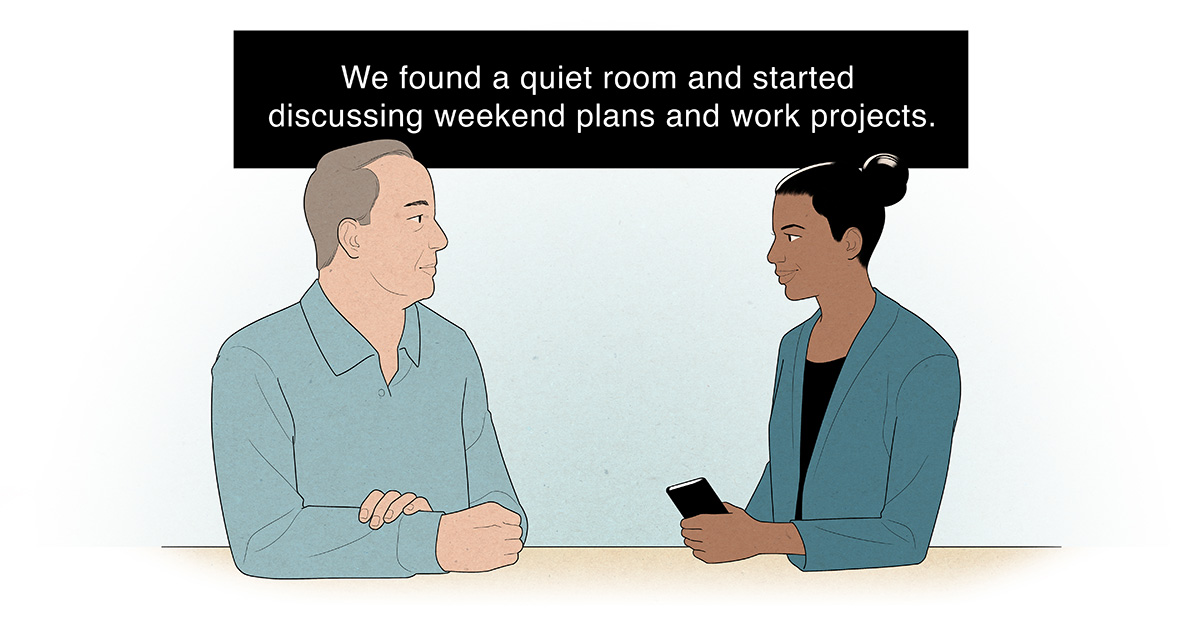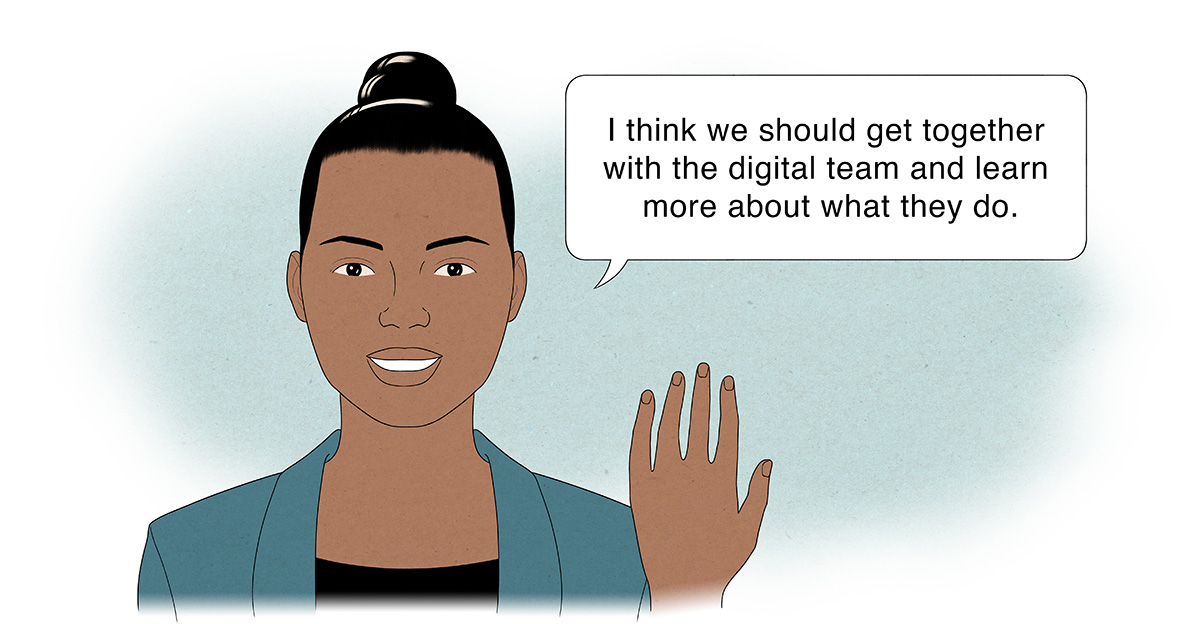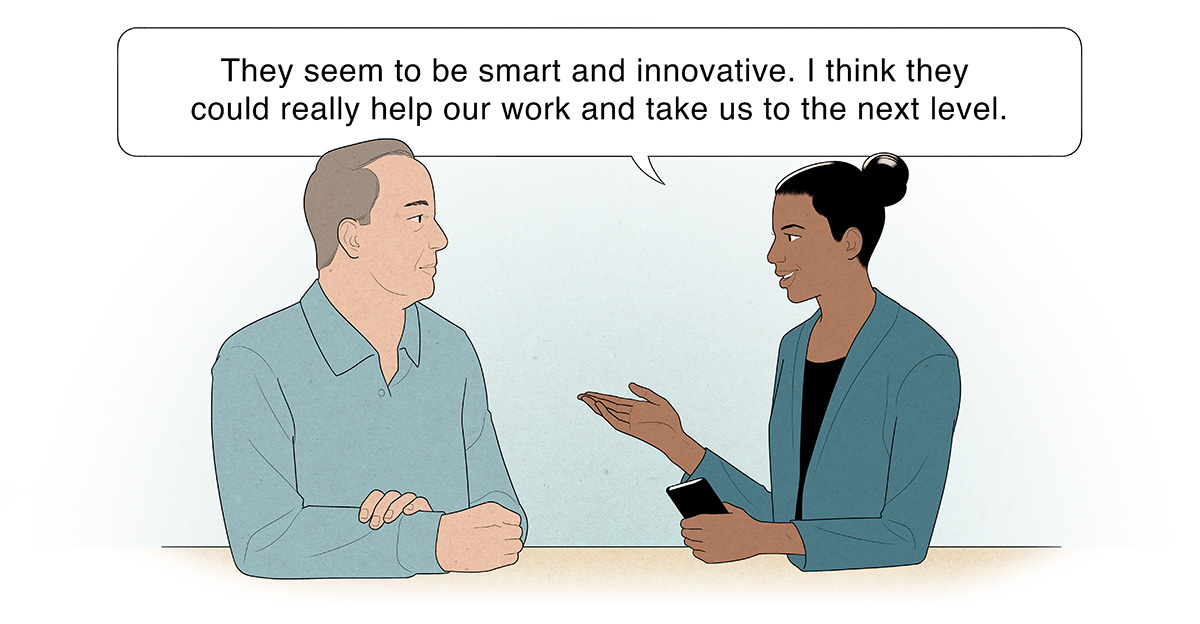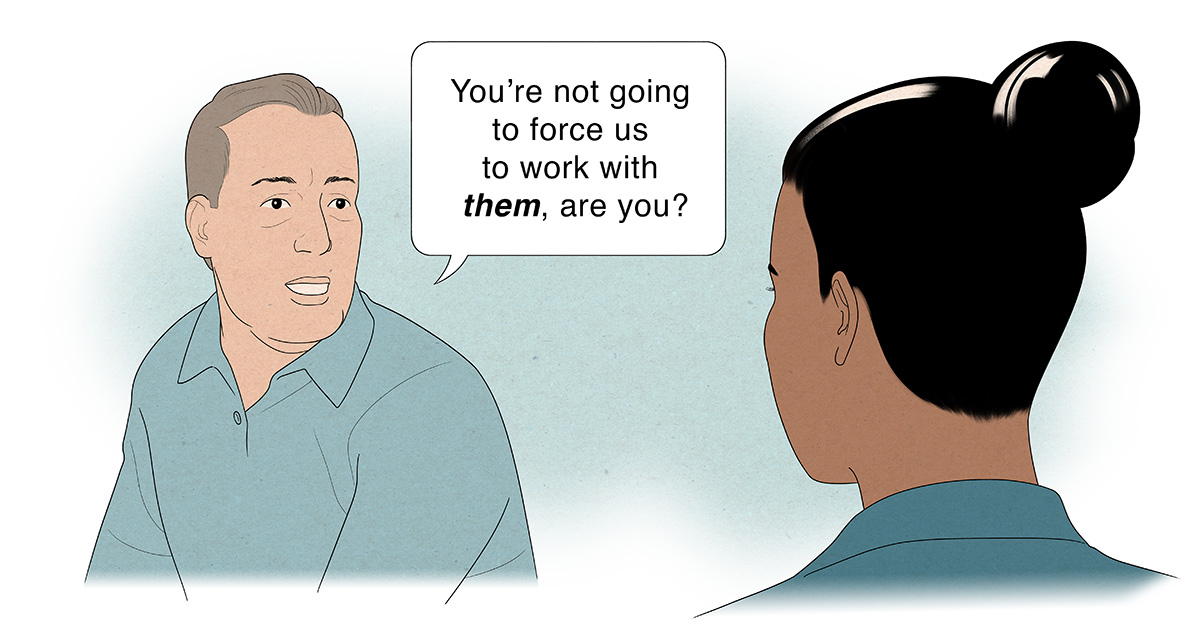I Was a Manager in an Ageist Workplace

几年前,我决定跟一位接近六十岁的团队成员聊聊。当时我刚当上管理者几星期,想了解员工如何适应这种变化。
A few years back, I decided to chat with one of my team members, a man in his late fifties. I had recently started a new position as a manager — was just a few weeks on the job — and I wanted to see how people were adjusting to the change.
聊着聊着,我找了个机会吐露自己的想法。
As the conversation continued, I found a moment to bring up something I’d been thinking about.
“你说吧。”这位员工显得有点怀疑,但也很好奇。我带领这支团队时间虽不长,却已经了解到他的才能和资历都令人敬重,所以如果能让他接受我的提议,其他人应该也会接受。
“OK,” my employee replied, slightly suspicious yet curious. During my short time leading the team, I’d learned he was admired for both his talent and his tenure. So, getting his buy-in could mean others would be open to my idea.

他沉默了,让我有些不安。但我坚持说下去,解释这种合作的意义——就像学习使用一种新的工具,向一个有创意的实体团队寻求支持。
He was silent, which made me a little uncomfortable. But I pressed on, explaining what the collaboration could mean — like learning new tools and fostering the support of a creative, visible group.

似乎格外漫长的一阵沉默后,他笨拙地调整了一下姿势。
After what seemed like forever, he awkwardly shifted his body.

这之后的几天,我又跟其他成员谈了很多次。我发现大部分团队成员——五六十岁、为组织做出了宝贵贡献的人——并不想跟“另一边的年轻人”共事。
This was the first of numerous concerning conversations I had over the next several days. I discovered that most of my team members — people in their fifties and sixties, many cherished contributors to our organization — had no desire to work with “those young people on the other side of the room.”
我还发现自己身在一种将年龄主义行为正常化的文化里,在这里对年轻同事做出肤浅的预设是可以接受的。反过来,年轻员工也经常轻视年长同事的技术能力和学习意愿。年轻人在公开场合和私下抱怨,说自己的知识、见解和技能得不到赏识,无法实现发展和进步。
I also learned I was in a culture that normalized ageist behavior — one where making surface-level assumptions about younger colleagues was acceptable. And it went both ways: Younger employees often disparaged older colleagues’ technical skills and willingness to learn. They lamented, publicly and privately, that their knowledge, insight, and skills weren’t appreciated and that they were being obstructed from developing and advancing.
我要求自己的团队与年轻员工合作项目,他们终于开始与数字团队开展频繁开放的合作。但这是我第一次在人们不看贡献、敬业程度和潜力,而是在一定程度上根据年龄判断他人价值的组织里工作。
After I required my team to work on projects with younger coworkers, eventually they began to collaborate with the digital team openly and often. But this was the first time I’d worked in an organization where people perceived each other’s value, to some degree, in terms of their age rather than their contribution, commitment, and potential.
经历过几次这样的事,我一直在思考年龄歧视及其对工作场所的影响。我一直在问:如何定义和识别工作中的年龄主义?管理者如何应对年龄主义?如果不采取措施,年龄主义可能会造成什么后果?
After this experience and several others, I continued to wonder about ageism and how it affects the workplace. And I haven’t stopped asking questions: How do we define and identify ageism at work? What can managers do about it? And what are the potential consequences if they do nothing?
什么是年龄主义
What Ageism Is
年龄主义的核心是基于年龄的歧视。美国的《就业年龄歧视法》禁止歧视40岁以上员工。世界卫生组织(WHO)将年龄主义分为几个层次:由于年龄产生的想法(刻板印象)、感受(偏见)、对他人乃至自己的行动(歧视)。WHO表示,年龄主义行为会影响身心健康,缩短寿命——最多可能缩短七年半。
At its core, ageism is discrimination based on age. In the United States, the Age Discrimination in Employment Act forbids it against people who are 40 or older. The World Health Organization (WHO) divides ageism into several layers: how we think (stereotypes), how we feel (prejudices), and how we act toward others or even ourselves (discrimination) because of age. Taken together, the WHO reports, those types of behaviors can affect physical and mental health and can even shorten people’s lives by up to seven and a half years.
研究者贾斯蒂娜·斯蒂品斯卡(Justyna Stypińska)和社会学家康拉德·图雷克(Konrad Turek)进行了广泛的研究,发现工作中的年龄主义有硬性和软性两种形式。硬性年龄歧视是违法行为,如因为年龄而解雇、降职或苛待员工。软性歧视,如阴阳怪气的玩笑和评论,不一定违法,且最常出现在人际互动中。软性歧视更为普遍,女性比男性更常遭遇软性歧视。这类歧视大半源于刻板印象,会让员工不重视同事的贡献和观点,乃至对同事的技能给出负面评价。
Researcher Justyna Stypińska and sociologist Konrad Turek conducted an extensive study that shows ageist behaviors at work can take two forms: hard and soft. Hard age discrimination is illegal or prohibited behaviors, such as firing, demoting, or severely harassing someone because of age. Soft discrimination, like an off-color joke or comment, isn’t necessarily illegal and mostly occurs in interpersonal interactions. The soft form is the more common one, and women experience it more often than men. Since soft discrimination is mostly rooted in stereotypes, it can lead to people not valuing coworkers’ contribution and perspectives and even negatively assessing their skill sets.
年龄主义文化的主要受害者是两个极端——最年轻和最年长的员工。前者被视为缺乏经验、能贡献的较少,因此可能难以找到工作,难以争取合理的薪资。而研究表明,年长员工难以获得晋升、招新工作和转行,女性和美国的少数族群尤其严重。年龄主义泛滥,年长员工虽然流失率低、工作表现好,却不仅会招致负面眼光,地位还可能比非常年轻的员工更低。
The primary victims of ageist work cultures tend to be at the poles — the youngest and oldest workers. Members of the first group are seen as inexperienced and having less to offer, which can make it difficult for them to find employment or negotiate with hiring managers for fair wages. Meanwhile, studies show older people struggle to get promotions, find new work, and change careers; this is particularly true for women and minority racial groups in the U.S. When ageism is rampant, older workers might be seen not only in a negative light but also as lower status than even very young peers, despite having lower turnover and high-rated job performance.
人们总是将世代等同于年龄,但宾夕法尼亚大学沃顿商学院教授彼得·卡佩利(Peter Cappelli)告诉我,年龄和世代并不完全一样。同一世代的人经历过某些特殊或影响力巨大的大事件,受到了独特的影响。年龄则更多的关乎人生阶段,如开始一份职业、要孩子或准备退休。
People often equate generation with age. But when I talked to Peter Cappelli, a professor at the Wharton School of the University of Pennsylvania, he told me age and generation are not exactly the same. A generation is created when people experience something so distinctive and powerful that it leaves a unique impression on you and your cohort. Age has more to do with life stages, such as starting a career, having children, or preparing for retirement.
年龄主义可能潜藏在工作场所的各个角落,对各团队产生负面影响,破坏团结,限制年轻员工和年长员工的贡献,而且让这部分员工被贬低和排斥。专家表示,如果管理者放任年龄主义行为,员工的工作满意度、投入度和敬业度都会下降。
In the workplace ageism can be insidious and pervasive and can have a negative influence across groups. It can dissolve solidarity, limit the contributions of younger and older employees alike, and lead to people being devalued and excluded. Experts say that if managers allow ageist behaviors to persist, employee job satisfaction, engagement, and commitment all decline.
如何识别工作中的年龄主义
How to Identify Ageism at Work
卡佩利说,年龄主义会出现在各个方面,首先是招聘。“你会看到招聘方的年龄偏见。”他说,甚至会在职位说明和面试中体现出来。有一些关键词通常与年轻人相联系,如新观念、新视角,还有“经验丰富”这样更正面地表达年长的措辞。招聘者如果让求职者填写学分绩点,就是有意无意地针对处于特定人生阶段的人——毕业没几年的人。再看看企业呈现在网站图片、营销材料和活动中的自身形象。“如果这些材料里出现的全都是非常年轻的人,就很能说明问题了。”卡佩利这样说。
According to Cappelli, ageism surfaces in different ways, starting with hiring. “You can see it in the recruiting side,” he told me, even in job descriptions and interviews. There are key words typically associated with youth, such as new ideas and fresh perspective, as well as more positive ways of saying “older,” like experienced. If hiring managers require an applicant to list a grade point average, consciously or not they’re targeting people in a certain stage of life — typically those within a few years of graduation. Look, too, at how the company presents itself through pictures on its website, marketing materials, and events. “If all you see are really young people, that tells you something,” Cappelli said.
年龄主义还会体现在HR事务和管理决策中:晋升、停职、培训、领导力发展和项目安排。获得培训准备晋升到重要职位的员工类型会传达一些关于年龄的信息。比方说,注重数字化技术的升职机会是不是全都给了年轻员工?
Ageism also appears in HR practices and management decisions: promotions, terminations, training, leadership development, and project assignments. The types of employees who are groomed for and elevated to important roles may convey messages about age. Is it the case, for instance, that younger workers get all the promotions for digital-focused jobs?
卡佩利说,办公室的活动也可能有问题。比如在下班后开桌上足球大会、提供无限量啤酒,可能只会吸引特定年龄层的员工。
Cappelli says that even office activities can be red flags. Offering foosball tournaments and unlimited beer after hours, for example, may attract workers of some age groups and not others.
为了协助识别年龄主义,管理者可以收集信息。与员工一对一非正式交流获得的定性资料有助于揭示一些原本可能忽略的隐忧。“挽留面谈”可以了解员工在决定离职或退休之前的感受。记住,要问开放式的问题,如“我可以如何为你提供支持?”“给你动力(或让你失去动力)的是什么?”
To help identify ageism, managers can collect data. Qualitative data from one-on-one, informal conversations with employees can help unearth concerns that might have gone unnoticed. “Stay interviews” provide insight into how people feel before they decide to leave or retire. Remember to ask open-ended questions like What can I do to support you? and What motivates (or demotivates) you?
还可以选择员工问卷调查等更正规的方法收集定量数据,以及在人力资源部门关于留任和离职员工的人事分析中寻找年龄方面的规律。
You can also use more-formal methods, such as employee surveys, to collect quantitative data. And look for age patterns in HR’s people analytics about who goes and who stays.
对抗工作中的年龄主义
Combating Ageism at Work
要对抗年龄主义,卡佩利鼓励管理者先从简单的措施着手,比如公司在视觉资料中呈现的员工形象:确保公司内部和面向公众的视觉资料里包含各年龄层的员工。
To combat ageism, Cappelli encourages managers to start with something simple, like how the company depicts employees visually. For example, ensure that in-office and public-facing images include people of all age groups.
更难的是改变行为:员工说什么、做什么、鼓励什么、接受什么。一切都归结于理解。《在多世代的工作场所如何领导并成功》(The Remix: How to Lead and Succeed in the Multigenerational Workplace)作者琳赛·波利亚克(Lindsey Pollak)说,管理者可以建立多世代的执行委员会,让不同年龄层的成员担任高管,以此推动改变。“现在经常看到高管办公室里全是年龄相仿的高管,年轻人都在开放式的办公区,中层管理者在别的地方。我觉着这种状况应该改变。”她还说,管理者必须努力了解所有年龄层的员工——并且让不同年龄层的员工了解彼此。
The harder work is in changing behaviors: what people say, do, encourage, and accept. It all comes down to understanding. Lindsey Pollak, author of the book The Remix: How to Lead and Succeed in the Multigenerational Workplace, says managers can ignite change by creating multigenerational committees and seating arrangements. “What you tend to see in an office is all the executives of one age sit in one place, all the young people are in the bullpen, and all the middle managers are elsewhere. And I think that should be abolished.” She also says managers must be deliberate in getting to know employees of all ages — and getting them to know one another.
领导者也不必让年龄主义在暗处酝酿。激发改变可以从言语开始。想一想人们关于年轻和年长员工的评论、玩笑和标签是否带有轻微的冒犯、偏见或漠不关心。明显的年龄主义用语,如“老资格”“年轻人”应当改为委婉的“有经验”“新人”。毫无必要地提及别人的年龄容易为冲突埋下隐患。还要想一想企业文化重视的是什么。研究表明,组织通常利用奖励机制建立规范。在你的公司里,招聘负责人聘用上升期的新人和已有一定成就的优秀员工是否能得到同等程度的认可?领导者是否同样称赞数字原住民的技能和年长员工长期积累的经验?组织要想繁荣发展,两者都不可或缺。
Leaders don’t have to let ageism quietly simmer, either. To spark change, start with language. Consider the comments, jokes, or labels people use to describe younger and older employees and whether they are microaggressions or are biased or insensitive. Overt terms, such as “old-timer” and “youngster,” should be eradicated, as should euphemisms like “seasoned” and “newbie.” Needless references to someone’s age set the stage for conflict. Think, too, about what your work culture values. Studies show organizations commonly use reward systems to shape norms. In your company, are managers who hire up-and-comers as celebrated as those who recruit established stars? Do leaders equally laud the skills of digital natives and the institutional knowledge of older workers? Both are needed for an organization to thrive.
应当鼓励年轻员工(以及各年龄层的招聘负责人)思考年长员工的优势:经验、社交技能、独立工作的能力。同样,年长员工应当了解年轻同事能带来什么,比如数字技术涵养和多元价值观。
Younger workers (and hiring managers of all ages) should be encouraged to think about the assets that older workers bring to the table: experience, social skills, the ability to work independently. Similarly, older workers should understand what younger peers can offer, such as being tech savvy and valuing diversity.
最后,招聘战略应当考虑到各种各样的人,包括年长和年轻的求职者。要像在大学生求职网站和其他访问量大的求职网站上发布招聘信息一样,面向有55岁及以上成员的组织进行招聘宣传。
Finally, recruiting strategies should yield a diverse group of people, including older and younger candidates. Advertise with organizations that have members 55 and older as well as on job boards for college students and other relevant, frequently visited employment sites.
我的收获
What I Learned
我还在思考如何让年长员工团队和年轻的数字化团队合作。
I still think about when I wanted to bring that group of older employees together with the younger digital team.
身为管理者,我必须明白年龄主义观念正在影响我们的工作,然后鼓起勇气,改变这种文化,建立起无论年长年少的每一个人都能感到舒适的环境。我知道这个问题只靠自己是无法解决的,于是请其他管理者让自己的团队跟我的下属合作项目,我们自己也参与进去以身作则。
As a manager, I had to understand how ageist ideas were affecting our work — and then be brave enough to change the culture and create an environment where everyone, however young or old, felt comfortable. Knowing this problem wasn’t something I could tackle on my own, I asked other managers to have their teams work on projects with my direct reports; to set a good example, we got in the trenches with them on those collaborations.
我还聘用各个年龄层的人,包括60岁以上和30岁以下的人,建立起年龄多元团队;帮助年轻员工和年长员工表达自己的想法,在组织内吸引更多关注;为自己团队的成员提供关于新技术的培训;提拔了一位年纪最大的员工。
I also built a mixed-age team by hiring people over 60, under 30, and all ages in between; helping young and older workers see their ideas through and become more visible in the organization; offering training in new technologies to my team members; and promoting one of my oldest employees.
我的团队和办公室的其他一些人,虽然最初有过疑虑,但终于学会了合作,不再担心年龄。几年过去,我们的包容性和创造性都有所提升。我们质疑现状,身体力行地实践了“铁与铁一起磨得锋利,人与人切磋亦是如此”的古话。差异帮助我们学习,让我们彼此都变得更好。
Despite the initial apprehension, my team and several others in the office eventually learned to work together without worrying about age. Through the years, we became more inclusive and creative. We challenged the status quo, and in some ways we became the personification of the adage “As iron sharpens iron, so one person sharpens another.” Our differences helped us learn, and we made each other better.
如今我督促自己职业网络里的管理者,发现年龄多元团队的价值。请你也帮助所有员工——从刚毕业的大学生到快要退休的人——了解,他们的贡献对于你的公司和产出有多么重要。
Today, I challenge managers in my professional network to see the value in mixed-age teams. And I’m asking you to help all employees — from recent college graduates to those nearing retirement — see how pivotal their contributions are to your outcomes and organization.
妮科尔·史密斯是《哈佛商业评论》编读交流负责人。
妮科尔·史密斯(Nicole D. Smith)| 文





